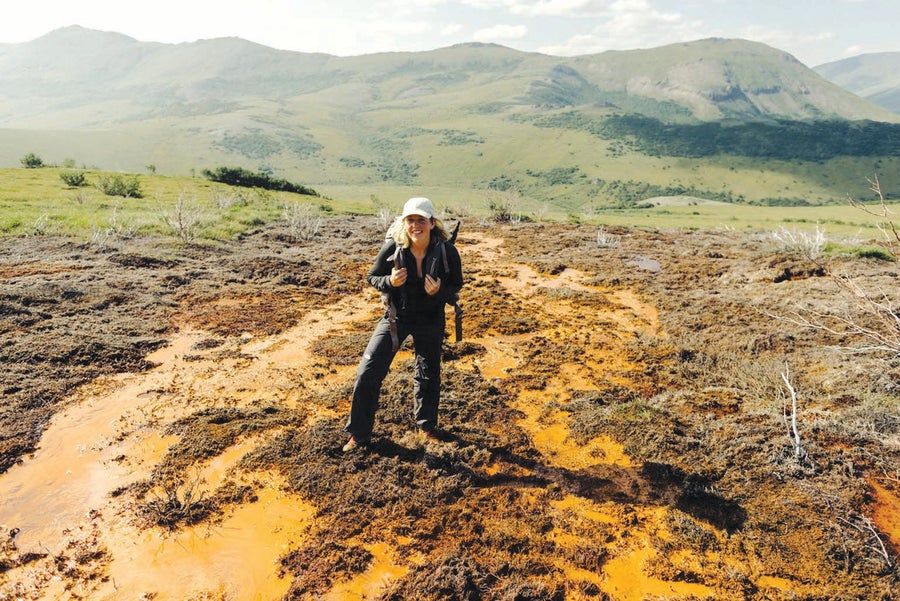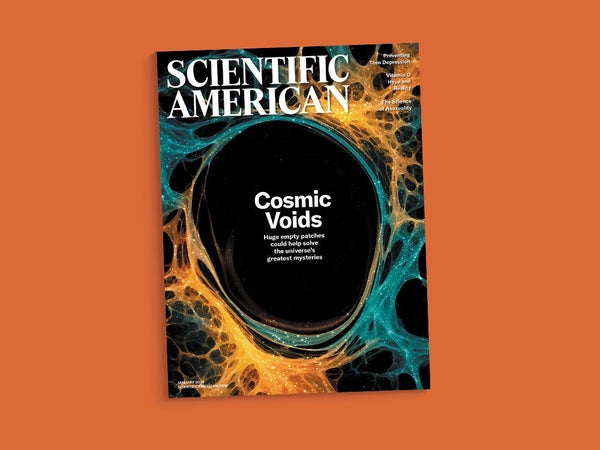Have you ever gotten a blood test result saying your vitamin D levels are low? Or heard that the vitamin is a miracle cure? It turns out fears about deficiencies, and hopes of the vitamin's healing power, have been wildly overblown. Author Christie Aschwanden explains why the evidence has pointed one way and then the other, and why blood tests can be misleading, in a story full of insights about the advancement of science. You need some vitamin D, though probably not supplements. We make vitamin D when sunlight hits our skin, like a human form of photosynthesis. The best way to get it, if you are able, is to spend more time outdoors—which tends to make everything better.
Prepare to look at the night sky in a different way after reading Michael D. Lemonick's article. The universe is full of ... voids. They are empty spaces where almost nothing currently knowable exists. Mike is a former editor at Scientific American and a longtime physics writer (and the nicest guy), and he's been following the mystery of the cosmic voids for decades. When they were discovered, they blew astronomers' minds, but now we have enough data and computing power to study these empty spaces, which could improve our understanding of gravity, dark matter and dark energy.
Depression can be a debilitating, chronic, episodic condition, and preventing it could save money, health and lives. Now there's strong evidence that prevention programs can help. Screening teenagers and helping at-risk kids learn emotional and cognitive skills can reduce the risk of early signs turning into mental illness. Science writer Elizabeth Svoboda discusses how to build these skills and why a focus on fixing rather than preventing problems makes it difficult for school systems to implement such programs. We hope our article will help broaden support for these kinds of initiatives. Prevention rarely gets as much appreciation as it deserves.
The photographs of Alaska's rusting rivers are real—the rivers really do look brilliant orange, and that is literally rust. Climate journalist Alec Luhn accompanied scientists studying these bizarre rivers to figure out what is causing the discoloration, and photographer Taylor Roades used drones to capture the scenes. Alaska is warming even faster than the Lower 48, and thawing permafrost there is changing ecosystems dramatically. Acid from newly exposed bedrock could be leaching out iron that later forms rust, or it might be bacteria or some other force.
Until recently, a general lack of feeling sexually attracted to others was often considered a psychological problem in itself or a symptom of some other disorder. Now asexual people and researchers who study asexuality have shown that it is just another way to be human. Allison Parshall, a writer and editor who works with us frequently (she edited this issue's Advances department), has a thoughtful story about the new cultural and scientific awareness of asexuality and how it is opening up new social norms.
You may have read about the discovery of a long-sought mathematical shape called an einstein tile that can cover an infinite surface without repeating a pattern. I thought I'd heard all about it ... but then I read computer scientist Craig S. Kaplan's account of its discovery. It is a delightful narrative, full of dramatic tension and charismatic characters who are having an absolute blast pursuing a new understanding of tiling patterns. The illustrations by Miriam Martincic are inspired by M. C. Escher, the artist whose dazzling repeated patterns were popularized in the U.S. by Scientific American. Enjoy the challenge of mentally fitting these pieces together in your own mind.
Contributors to Scientific American’s January 2024 Issue
Writers, artists, photographers and researchers share the stories behind the stories

Taylor Roades
Rusting Rivers
Last summer photojournalist Taylor Roades traveled to Arctic Alaska to capture the region's contaminated waterways in startling color. Before the trip, she had seen only an aerial smartphone photograph of these rivers, featured in Alec Luhn's article about the mysterious climate change–driven processes polluting them with rust. Roades, who has been camping in the Canadian backcountry since she was a child, ran through most of her drone's battery life early in the trip—surely the orange-tinted rivers they were seeing were as bad as it would get? Then, around day four, she and the team of scientists reached swaths of blackened land where vibrant orange sludge seeped from the ground like lava. “That was shocking,” even for the scientists, she says.
Roades grew up in Toronto but moved west to British Columbia in 2013 in a “very conscious effort” to immerse herself—and her photography—in forests and oceans. Her work has documented Canada's “forgotten rainforests” where old-growth trees are threatened by logging and a coastal B.C. First Nation that is reclaiming and protecting its ancestral land. In a world rocked by climate change and environmental degradation, this work feels like a moral imperative. “What am I going to say to my future kids? That I did nothing or that I put my effort and skills into stopping it?”
Michael D. Lemonick
Cosmic Nothing
Mike Lemonick's father was his own personal Carl Sagan, a physicist who fostered his son's love of the cosmos with stories of Halley's Comet. The comet was overhead when Mark Twain was born and then again as he lay on his deathbed, or so the story goes. The comet was coming again in 1986—”the distant future, or so it seemed to me in the 1950s,” Lemonick says. That appearance turned out to be a dud, “but by then I was hooked.” In 1986 he was an editor at the magazine Science Digest when a non-comet-related revelation rocked the field of cosmology: matter isn't evenly spread through the universe, as previously thought, but clumps together into clusters.
In the ensuing decades, those clusters received almost all the attention. But what about the voids they left behind? “They were ignored for decades,” says Lemonick, a lecturer at Princeton University and a former Scientific American editor. For this issue, he wrote about the physicists who are shining a spotlight into these voids to solve some of cosmology's biggest mysteries. “It's a very old story,” he says—yet also, somehow, brand-new.
Martin Krzywinski
Cosmic Nothing
A lifelong stargazer, Martin Krzywinski was fascinated by anything to do with astronomy, first as a child in Warsaw, Poland, and then in Canada. So when he stumbled on a video five years ago about something called the Boötes void, he was intrigued. He knew Boötes as the kite-shaped constellation that hosts the star Arcturus. But that this familiar constellation contained a massive swath of cosmic nothingness was entirely new to him. “It was like love at first thought,” he reflects. “I can't let this go.” Krzywinski, who alternates between calling himself an artistic scientist and a scientific artist, immediately began crafting a map of empty spaces such as the Boötes void across the universe, which he has adapted into a graphic for this issue.
The big illustration challenge was giving these empty spaces character; most don't even have names. To Krzywinski, that's all the more intriguing. “What really interests me are these giant places far away that are difficult to imagine,” he says, because that imagination fosters an emotional connection. “I'm more likely to emotionally relate to something that is unseen and unknowable.”
Christine Aschwanden
The Rise and Fall of Vitamin D
Thirteen years ago Christie Aschwanden wrote a cover story for Reader's Digest debunking the health benefits of multivitamins. “I think it set a record for the most angry letters to the editor,” she recalls—not because anything was incorrect but because many people are very attached to their vitamins. “There was a time when we thought that if we could just get everyone's vitamin D levels up, that could really improve overall health,” she says.
As Aschwanden shows in her article, it is now clear that vitamin D may be associated with good health but is probably not its cause. Most of us get plenty of the substance without supplements. While reporting the story, she was surprised to learn how many of her friends and loved ones had recently been told they were deficient in vitamin D by their doctors. The idea “that vitamin pills are somehow magic elixirs—it's very tempting,” she says. “We're all after that one weird trick.”
